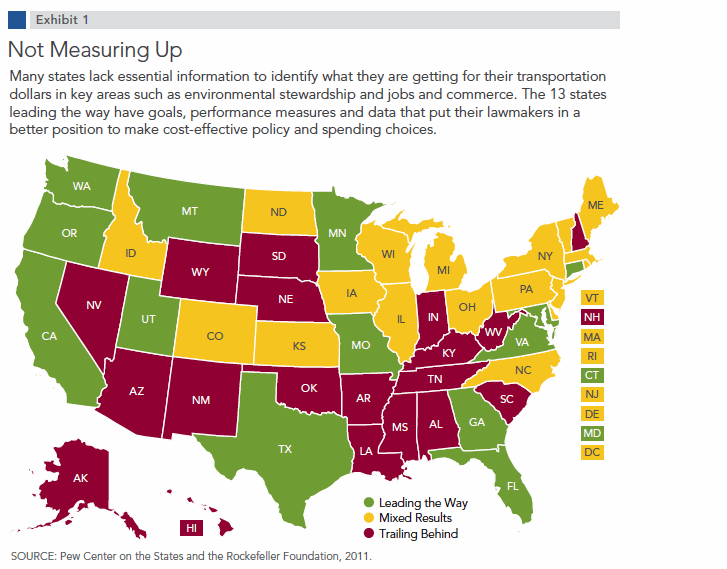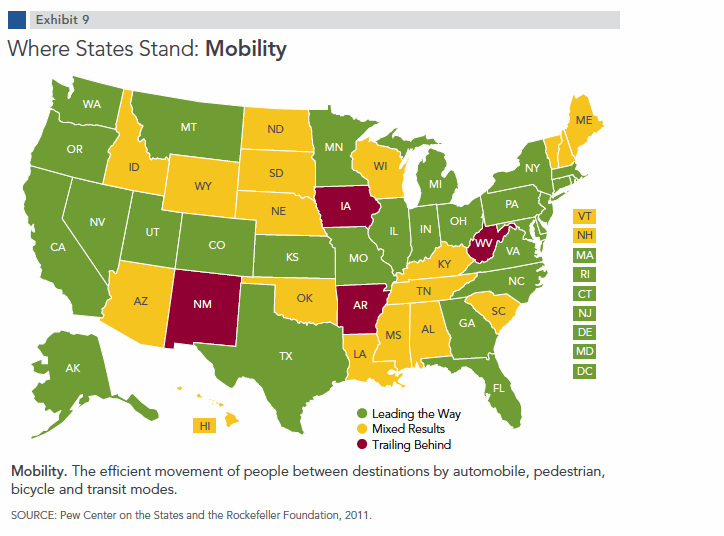PEW CENTER ON THE STATES & ROCKEFELLER FOUNDATION
Executive Summary
In fiscal year 2010, states spent an estimated $131 billion in taxpayer dollars on transportation. Yet many policy makers cannot answer critical questions about what results this investment is generating. Just 13 states—California, Connecticut, Florida, Georgia, Maryland, Minnesota, Missouri, Montana, Oregon, Texas, Utah, Virginia and Washington—have goals, performance measures and data needed to help decision makers ensure their surface transportation systems are advancing economic growth, mobility, access and other key policy outcomes. Nineteen states trail behind, lacking a full array of tools needed to account for the return on investment in their roads, highways, bridges and bus and rail systems. The remaining 18 states and Washington, DC, fall someplace in between, with mixed results. Three of those—Colorado, Michigan and Pennsylvania—just missed earning the top distinction. (See Exhibit 1.)
These are the key findings of a study by the Pew Center on the States and the Rockefeller Foundation, based on a review of publicly available documents and interviews with scores of state and federal officials and experts in the field.
State policy makers want to demonstrate they are delivering the most cost-effective services possible for the public. Today, it is more important than ever that every tax dollar spent on transportation generates the best results and advances states’ short-and long-term economic interests. Most states are entering their fourth year of the ongoing budget crisis, with revenues far below pre-recession levels and expenditures rising—and policy makers around the country are making tough choices about where to spend limited resources. Meanwhile, some members of Congress are proposing that the next surface transportation reauthorization act, the law that governs the largest federal funding streams for states’ transportation systems, move from a compliance-based to a performance-based approach and more closely tie dollars to outcomes.
The goal of this assessment of the 50 states and Washington, DC, is to identify which are doing the best in terms of having essential tools in place to make cost-effective transportation funding and policy choices—and to help lawmakers understand how to use these tools to do a better job with limited dollars. The research examines six policy areas affected by those choices that are particularly important to states’ economic wellbeing and taxpayers’ quality of life: safety, jobs and commerce, mobility, access, environmental stewardship and infrastructure preservation.
To advance these broader objectives, state lawmakers must make transportation policy and spending choices based on solid information about what works and what does not. But unless states have clear goals, performance measures and good data in place to generate that information, it is very difficult for policy makers to prioritize transportation investments effectively, target scarce resources and help foster economic growth. The Pew-Rockefeller assessment reveals considerable differences among the 50 states in linking their transportation systems to and measuring their ongoing performance toward these important policy goals.
Download full version (PDF): Measuring Transportation Investments
About the Pew Center on the States
www.pewcenteronthestates.org
“The Pew Center on the States is a division of The Pew Charitable Trusts that identifies and advances effective solutions to critical issues facing states. Pew is a nonprofit organization that applies a rigorous, analytical approach to improve public policy, inform the public and stimulate civic life.”
About The Rockefeller Foundation
www.rockefellerfoundation.org
“The Rockefeller Foundation supports work that expands opportunity and strengthens resilience to social, economic, health and environmental challenges—affirming its pioneering philanthropic mission since 1913 to promote the well-being of humanity.”








 RSS Feed
RSS Feed